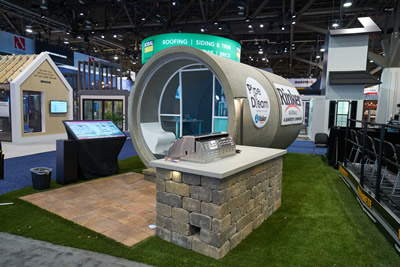To address the current housing epidemic impacting the country, Rinker Materials and the American Institute of Architecture Students launched the Pipe Dream design contest late last year, challenging AIAS members to design a tiny home from two 96- x 96-in. diameter concrete pipes. Architectural student Sandra D. Guillen’s winning concept became the first tiny home built from concrete pipe in the U.S. when it was constructed at the International Builders’ Show in Las Vegas earlier this year.
|
|
  |
| The four-section modular Pipe Dream home features a 12-in. radiant electric cooktop in the kitchen, collapsible bed, couch and workstation in a combination bedroom/office, and a paver planter outside for sustainable gardening. PHOTOS: Rinker Materials, a Quikrete Company |
  |
| Traditionally used for underground stormwater management, Rinker Materials views its 30-ton concrete pipe as the next generation of modular tiny homes that can be assembled in less than a day. |
 |
Guillen’s design bested more than 50 submissions by focusing on function and comfort. Extending the natural cool gray of the concrete pipe, Guillen integrated light blues and off whites to create a soft, welcoming feel as well as make the nearly 100 sq.-ft. home seem much larger. The effect of enlarging the tiny home was also accomplished by incorporating tile surfaces, large French glass front doors and two retractable glass windows in the rear. A covered porch and large paver patio with grill significantly increased the outside living space. To streamline the process, Rinker Materials turned to fellow Quikrete companies, Custom Building Products and Keystone Hardscapes, for the tile and paver installation, respectively.
“Exploring our concrete pipe as a tool to fight homelessness and overpopulation alongside the AIAS has already proven to be a viable prospect,” said Tom Hartley, vice president of Sales & Marketing for Rinker Materials. “Sandra’s unique perspective resulted in a smart, repeatable design that could truly make tiny concrete pipe homes accessible to anyone. Combine that with our national distribution and there isn’t a community we couldn’t potentially help. Ultimately, our long-term goal is partnering with HUD, FEMA and similar organizations to make tiny concrete pipe homes a reality for those in need.”
The wooden-frame, four-section modular tiny home design—kitchen, bathroom, living area and combination bedroom/office—can be assembled in a Rinker Materials concrete pipe in less than a day (excluding electricity and plumbing). The 30-ton, fire-resistant concrete pipe can be easily transported on a flatbed truck and simply requires eight commercial-grade rubber wheel chocks to stabilize the tiny home. While amenities will dictate the final cost of a tiny home built from concrete pipe, which is about $14,000, the prototype revealed at the International Builders’ Show was about $35,000.
